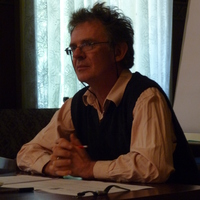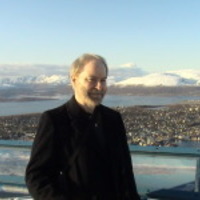Papers by Albert Naccache
We present here a network model designed to check if the simple addition of structure through the... more We present here a network model designed to check if the simple addition of structure through the diversification of social actors could progressively morph the random social communication networks of early Homo to the small-world communication networks of late Paleolithic hunter-gatherers (Naccache, 2012). The analysis of the network model confirmed the possibility of the transition, and in addition provided us with new insights in both the processes of network construction and of language evolution.
Experimental Neurology, 1974
European Journal of Pharmacology, 1972
eproceedings.worldscinet.com
In order to probe the emergence of predication in our lineage we use Bogdan’s analysis of the soc... more In order to probe the emergence of predication in our lineage we use Bogdan’s analysis of the social ontogeny of propositional thinking in today’s infants (2009). First, we see that early H. erectus had the cognitive potential for Bogdan’s three “roots of predication,” potential which would have been selected for among cooperative breeders. Then we estimate when the cognitive abilities required for three of the stages of Bogdan’s “assembly staircase” would have been present, and, based on the lithic record, conclude that ~1 mya Homo’s linguistic communication system would have included predication.
The emergence of the specifically human life history stages of Childhood, Adolescence, and Postre... more The emergence of the specifically human life history stages of Childhood, Adolescence, and Postreproductive Lifespan must have affected hominin communities at the social, cognitive and communicative levels. Here we explore and try to identify what were the effects of the emergence of each new human life history stage on the social structures of hominin communities, then what were some of the effects of the new social structures on hominin distributed cognition, and, finally, what could these changes have meant for the evolution of the human linguistic communication system.

During the last few decades our “mechanistic” scientific worldview has been superseded by a “unif... more During the last few decades our “mechanistic” scientific worldview has been superseded by a “unified” one, better able to account for all phenomena, from the smallest and simplest to the largest and most complex. The shock-wave is now reaching the Social Sciences and Humanities, rendering obsolete all their underlying theoretical paradigms still reflecting, positively or negatively, the old scientific worldview. We have therefore no choice but to start overhauling these paradigms, as Cauvin prodded us to do for the field of Neolithic studies, which is in need of « une relecture générale des données disponibles plutôt que le replâtrage au jour le jour de la théorie existante » (Cauvin 1997: 19).
I have recently proposed an overarching framework designed to integrate Human History into the Natural Sciences (Naccache 1999). Here I would like to use it to help reflect upon the phenomena of accumulation and emergence in Cultural Evolution, using the Neolithic “Revolution” of the Near East as a data-base. To provide a methodological grounding, we start with an overview of the changing theoretical assumptions subtending the field of Neolithic studies. Then we sketch how selected evolutionary and cognitive approaches can be combined into a framework offering a descriptive perspective on Human History, compatible with modern Darwinian Evolutionary thinking, and yet not reductive of Culture to Biology. The final part illustrates how this framework could be fleshed-out from the Near East Neolithic archaeological data-base, and the kind of heuristic patterns that can be discerned when this is done.
… delivered at Evolutionary Epistemology, Language and …, 2004
This paper uses the framework of Modes of Evolution (Naccache 1999) to structure a historical ske... more This paper uses the framework of Modes of Evolution (Naccache 1999) to structure a historical sketch of human language’s emergence and accretion. After presenting the formal pattern in the evolution of life cycle setups upon which the framework is based, and reviewing the relevant aspects of evolution from bacteria to the last common ancestor (LCA) of Homo and Pan, this paper illustrates how the framework can be used to identify: - three stages in the organic evolution of the potential for linguistic behavior that transformed the LCA communication system into the species-wide shared potential for language characterizing anatomically modern humans; - and four landmarks along the path of socio-cultural accretion of human language(s), from Paleolithic to early ‘Historic’ times.
Archaeology, 1996
Résumé/Abstract L'auteur rapporte comment les intérêts des promotteurs chargés de la reconstr... more Résumé/Abstract L'auteur rapporte comment les intérêts des promotteurs chargés de la reconstruction de Beyrouth et la hâte à reconstruire et à développer la cité moderne a conduit à la perte définitive d'un grand nombre de vestiges archéologiques, à cause de ...
Archaeology Under Fire will be essential …, 1998
History and Theory, Jan 1, 1999











Uploads
Papers by Albert Naccache
I have recently proposed an overarching framework designed to integrate Human History into the Natural Sciences (Naccache 1999). Here I would like to use it to help reflect upon the phenomena of accumulation and emergence in Cultural Evolution, using the Neolithic “Revolution” of the Near East as a data-base. To provide a methodological grounding, we start with an overview of the changing theoretical assumptions subtending the field of Neolithic studies. Then we sketch how selected evolutionary and cognitive approaches can be combined into a framework offering a descriptive perspective on Human History, compatible with modern Darwinian Evolutionary thinking, and yet not reductive of Culture to Biology. The final part illustrates how this framework could be fleshed-out from the Near East Neolithic archaeological data-base, and the kind of heuristic patterns that can be discerned when this is done.
I have recently proposed an overarching framework designed to integrate Human History into the Natural Sciences (Naccache 1999). Here I would like to use it to help reflect upon the phenomena of accumulation and emergence in Cultural Evolution, using the Neolithic “Revolution” of the Near East as a data-base. To provide a methodological grounding, we start with an overview of the changing theoretical assumptions subtending the field of Neolithic studies. Then we sketch how selected evolutionary and cognitive approaches can be combined into a framework offering a descriptive perspective on Human History, compatible with modern Darwinian Evolutionary thinking, and yet not reductive of Culture to Biology. The final part illustrates how this framework could be fleshed-out from the Near East Neolithic archaeological data-base, and the kind of heuristic patterns that can be discerned when this is done.